Related Research Articles
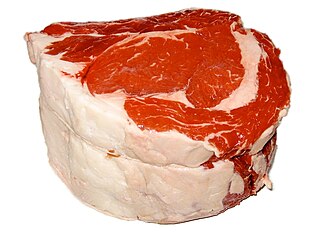
Beef is the culinary name for meat from cattle, particularly skeletal muscle. Humans have been eating beef since prehistoric times. Beef is a source of high-quality protein and nutrients.

Highland cattle, also called long-haired Highland cattle, long-haired Scottish cattle, North Highland cattle, Scottish cattle, Scottish Highland cattle, and West Highland cattle, are a Scottish breed of cattle descended from the Black Kyloe.They have long horns and long, wavy, woolly coats that are coloured red, ginger, black, dun, yellow, white, grey, "silver", or tan, and they also may be brindled. Highlands are raised primarily for their meat. They originated in the Highlands and Outer Hebrides islands of Scotland and were first mentioned in the 6th century AD. The first herd book described two distinct types of highland cattle but crossbreeding between the two has brought about only one extant, registered type. They have since been exported worldwide.
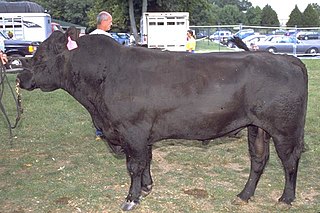
The Aberdeen Angus, sometimes simply Angus, is a Scottish breed of small beef cattle. It derives from cattle native to the counties of Aberdeenshire and Angus in north-eastern Scotland.

The Hereford is a British breed of beef cattle that originated in the county of Herefordshire, in the West Midlands of England. It has been exported to many countries, and there are more than five million purebred Hereford cattle in over fifty nations worldwide. The breed was first exported from the United Kingdom in 1817, initially to Kentucky, and spreading across the United States and Canada, through Mexico, to the great beef-raising countries of South America. Today, Hereford cattle dominate the world scene from Australasia to the Russian steppes. They can be found in Israel, Japan and throughout continental Europe and Scandinavia, in the temperate parts of Australia, Canada, the United States, Kazakhstan and Russia, in the centre and east of Argentina, in Uruguay, in Chile, and in New Zealand, where they make up the largest proportion of registered cattle. They are found all around Brazil and they are also found in some Southern African countries. They originally found great popularity among ranchers of the American Southwest, testament to the hardiness of the breed; while originating in cool, moist Britain, they have proven to thrive in much harsher climates on nearly every continent.

Holstein Friesians are a breed of dairy cattle originating from the Dutch provinces of North Holland and Friesland, and Schleswig-Holstein in Northern Germany. They are known as the world's highest-production dairy animals.

The Red Angus is a breed of reddish-brown-coloured beef cattle. It derives from the population of Aberdeen Angus cattle and, apart from the coat colour, is identical to it. Red Angus are registered separately from black Angus cattle in Australia, Canada, and the United States.

Wagyu is any of the four Japanese breeds of beef cattle.

Murray Grey is a breed of Australian polled beef cattle that was developed in the upper Murray River valley on the New South Wales-Victoria border. They have evolved into a versatile breed that does well in a wide range of environments and produces top-quality carcases.
Brangus is a hardy and popular breed of beef cattle, a cross between an Angus and a Brahman. Animals eligible for registration as Brangus cattle are 5/8 Angus and 3/8 Brahman. Brangus is a registered trademark of the International Brangus Breeders Association (IBBA).

The Limousin, French: Limousine, is a French breed of beef cattle from the Limousin and Marche regions of France. It was formerly used mainly as a draught animal, but in modern times is reared for beef. A herd book was established in France in 1886. With the mechanisation of agriculture in the twentieth century, numbers declined. In the 1960s there were still more than 250 000 head, but the future of the breed was not clear; it was proposed that it be merged with the other blonde draught breeds of south-western France – the Blonde des Pyrénées, the Blonde de Quercy and the Garonnaise – to form the new Blonde d'Aquitaine. Instead, a breeders' association was formed; new importance was given to extensive management, to performance recording and to exports. In the twenty-first century the Limousin is the second-most numerous beef breed in France after the Charolais. It is a world breed, raised in about eighty countries round the world, many of which have breed associations.
The Red Angus Association of America (RAAA) was formed in 1954 by seven breeders of reds cropped from best black Aberdeen Angus herds in the United States. RAAA was designed around the new scientific principles of performance testing. The Association's first president, Waldo Forbes, Sr., summed-up the vision of the founding members:
The policy of the Association is to discourage the more artificial practices in purebred cattle production and to place its faith instead in objective tests, consisting for the most part of comparisons within herds of factors of known economic importance and known heritability... By making this an integral part of the registration system, Red Angus breeders feel that even faster progress can be made toward the ultimate goal of more efficient beef production.
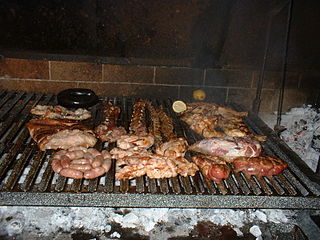
Beef is a key component of traditional Argentine cuisine.

Shetland cattle are a small, hardy cattle breed from the Shetland Isles of Scotland. They are noted for their use in crofting in Shetland, where they provided use for meat, milk and draft work. Despite the rapid decline in crofting for a living, efforts to conserve this breed in the United Kingdom are mainly done by the Shetland Cattle Breeder's Association.

Leroy Kershaw (1880–1969) was an American attorney, banker, businessman, cattleman and political candidate.

The Australian Lowline is a modern Australian breed of small, polled beef cattle. It was the accidental result of a selective breeding experiment using black Aberdeen Angus cattle at the Agricultural Research Centre of the Department of Agriculture of New South Wales at Trangie. It is among the smallest breeds of cattle, but is not a dwarf breed.

Black Baldy is a type of crossbred beef cattle produced by crossing Hereford cattle with a solid black breed, usually Aberdeen Angus. Angus bulls are also used on Hereford heifers in an attempt to produce smaller calves and reduce dystocia. The term is particularly used in Australia and New Zealand. In North America, the term "Black Whiteface" is also used in some regions.

The Canadian Speckle Park is a breed of cattle native to the Canadian province of Saskatchewan. It is one of only a few beef cattle breeds developed in Canada. The latter half of the breed's name derives from the characteristic white, black and grey spots and patches of color that it is known for.
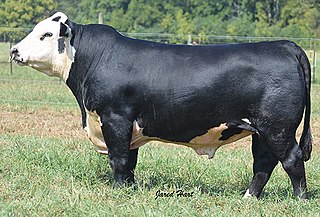
The Black Hereford is a beef cattle breed, derived mainly from Hereford cattle, but with some mixture from black Angus cattle, resulting in black cattle with a white head and finching.
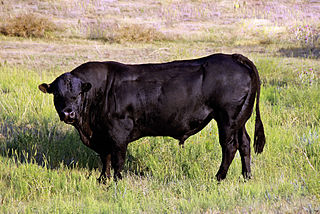
North American Piedmontese cattle are a breed of domestic beef cattle originating from an imported herd of select Italian purebred Piedmontese cattle. The foundation line of breeding stock was first imported from Italy into Canada in 1979, and into the United States in the early 1980s. Piedmontese cattle are distinguished by a unique, naturally occurring gene identified as the myostatin allele mutation, or inactive myostatin gene. Myostatin prohibits muscle growth whereas an inactive gene has the opposite effect. Purebred Piedmontese are homozygous,, which means they have two identical alleles present for this unique gene. Research indicates the presence of the myostatin allele mutation produces morphological characteristics unique to the breed, such as double-muscling, beef tenderness, reduced fat content and high yield. According to the North American Piedmontese Association (NAPA), they are the first breed registry to base animal registration requirements on the presence of this specific gene which can be easily verified by DNA testing.

The Red Brangus is a breed of hybridised cattle developed to optimise the superior characteristics of Angus and Brahman Cattle. The breed's hybridisation stabilises at a ratio of 3/8 Brahman and 5/8 Angus. The breed is relatively new respectively, with the first breeding trial conducted in 1912 in Jeanerette, Louisiana, United States. of America